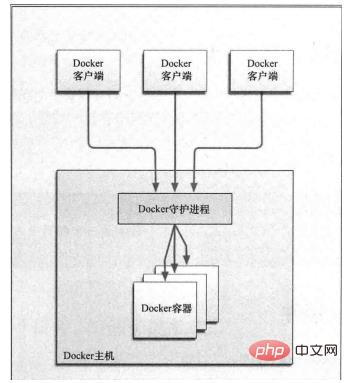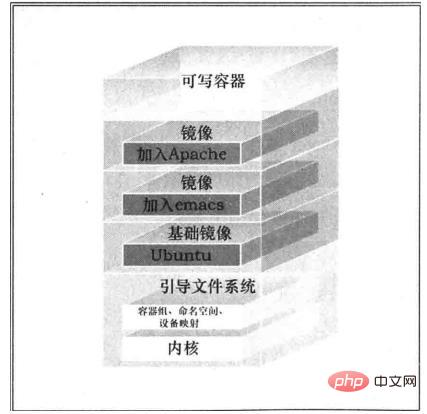What are the internal components of docker?
Docker internal components include: 1. dockerclient, which is a general term. It can be a command line docker or a client that follows the docker api rules; 2. dockerserver server; 3. Docker image, This is a read-only template and is the basis for starting a container; 4. Registry, which is a mirror warehouse; 5. Docker container.

The operating environment of this tutorial: linux7.3 system, docker version 19.03, Dell G3 computer.
What are the internal components of docker?
The core components of docker are as follows:
1. Client: dockerclient
2. Server: dockerserver
3. Docker image
4. Registry
5. Docker container
This article will briefly introduce the functions of these components and briefly describe how they cooperate with each other
1 , docker client and server
Docker client sends a request to docker daemon, docker daemon completes the corresponding task and returns the result to the container
docker client is a general term, it can be a command line Docker can also be a client that follows the rules of docker api. Simply put, it can be understood as an interface for interacting/sending instructions.
As shown below:

2. Docker image
The docker image is a read-only template and is the basis for starting a container. This includes the file system structure and content of the container, which together with the docker configuration file constitute the static file system environment of the docker container.
The docker image has many special features in its design:
Layered mechanism
Docker's mirroring mechanism is hierarchical, and one mirror can be placed on top of another mirror. The one at the bottom is the parent image, and so on; the image at the bottom can be called the base image. When finally starting a container from an image, docker will load a read-write file system on the top layer of the image. The program we want to run on docker is executed in this read-write layer.
I’m afraid you didn’t understand, the picture above

#When I start the container, we are exposed to the top-level writable container and the top-level image It is built iteratively from the image at its distribution layer. Next, another feature of the docker image is introduced, copy-on-write:
2) Copy-on-write
Look at the picture just now. The container and top-level image can be written when it first starts running. The content is completely consistent; when I modify the content, the file will be copied from the next layer of mirror (read-only layer) to the top-level writable container (read-write layer). The files in the read-only layer still exist, but It will be hidden by the files in the read-write layer; all operations done in the container will not affect the original underlying data unless you package it into a new image.
3) Content addressing and joint mounting
. . . Let me be lazy and use Baidu if you are interested
3. Registry
Where can we get the image? If we start a container through a certain image for the first time, first the host will go back to the /var/lib/docker directory to find it. If it is not found, it will go to the registry to download the image and store it in the virtual machine, and then complete the startup.
Registry can be imagined as a mirror warehouse. The default registry is the registry service officially provided by docker, called Docker Hub. Of course, you can also build your own mirror warehouse.
4. Docker container
The container is the running instance of the image.
Users can start, stop, move or delete containers through the command line or API. It can be said that for application software, the image is the construction and packaging phase of the software life cycle, while the container is the startup and running phase.
Recommended learning: "docker video tutorial"
The above is the detailed content of What are the internal components of docker?. For more information, please follow other related articles on the PHP Chinese website!

Hot AI Tools

Undresser.AI Undress
AI-powered app for creating realistic nude photos

AI Clothes Remover
Online AI tool for removing clothes from photos.

Undress AI Tool
Undress images for free

Clothoff.io
AI clothes remover

Video Face Swap
Swap faces in any video effortlessly with our completely free AI face swap tool!

Hot Article

Hot Tools

Notepad++7.3.1
Easy-to-use and free code editor

SublimeText3 Chinese version
Chinese version, very easy to use

Zend Studio 13.0.1
Powerful PHP integrated development environment

Dreamweaver CS6
Visual web development tools

SublimeText3 Mac version
God-level code editing software (SublimeText3)

Hot Topics
 1660
1660
 14
14
 1416
1416
 52
52
 1310
1310
 25
25
 1260
1260
 29
29
 1233
1233
 24
24
 How to exit the container by docker
Apr 15, 2025 pm 12:15 PM
How to exit the container by docker
Apr 15, 2025 pm 12:15 PM
Four ways to exit Docker container: Use Ctrl D in the container terminal Enter exit command in the container terminal Use docker stop <container_name> Command Use docker kill <container_name> command in the host terminal (force exit)
 How to copy files in docker to outside
Apr 15, 2025 pm 12:12 PM
How to copy files in docker to outside
Apr 15, 2025 pm 12:12 PM
Methods for copying files to external hosts in Docker: Use the docker cp command: Execute docker cp [Options] <Container Path> <Host Path>. Using data volumes: Create a directory on the host, and use the -v parameter to mount the directory into the container when creating the container to achieve bidirectional file synchronization.
 How to start containers by docker
Apr 15, 2025 pm 12:27 PM
How to start containers by docker
Apr 15, 2025 pm 12:27 PM
Docker container startup steps: Pull the container image: Run "docker pull [mirror name]". Create a container: Use "docker create [options] [mirror name] [commands and parameters]". Start the container: Execute "docker start [Container name or ID]". Check container status: Verify that the container is running with "docker ps".
 How to restart docker
Apr 15, 2025 pm 12:06 PM
How to restart docker
Apr 15, 2025 pm 12:06 PM
How to restart the Docker container: get the container ID (docker ps); stop the container (docker stop <container_id>); start the container (docker start <container_id>); verify that the restart is successful (docker ps). Other methods: Docker Compose (docker-compose restart) or Docker API (see Docker documentation).
 How to check the name of the docker container
Apr 15, 2025 pm 12:21 PM
How to check the name of the docker container
Apr 15, 2025 pm 12:21 PM
You can query the Docker container name by following the steps: List all containers (docker ps). Filter the container list (using the grep command). Gets the container name (located in the "NAMES" column).
 How to start mysql by docker
Apr 15, 2025 pm 12:09 PM
How to start mysql by docker
Apr 15, 2025 pm 12:09 PM
The process of starting MySQL in Docker consists of the following steps: Pull the MySQL image to create and start the container, set the root user password, and map the port verification connection Create the database and the user grants all permissions to the database
 How to update the image of docker
Apr 15, 2025 pm 12:03 PM
How to update the image of docker
Apr 15, 2025 pm 12:03 PM
The steps to update a Docker image are as follows: Pull the latest image tag New image Delete the old image for a specific tag (optional) Restart the container (if needed)
 How to create containers for docker
Apr 15, 2025 pm 12:18 PM
How to create containers for docker
Apr 15, 2025 pm 12:18 PM
Create a container in Docker: 1. Pull the image: docker pull [mirror name] 2. Create a container: docker run [Options] [mirror name] [Command] 3. Start the container: docker start [Container name]




